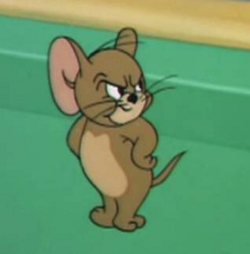Moegirlpedia would welcome your assistance in improving this article☆Kira~
As you read this article, you're welcome to participate in editing this page. Before editing, please read the wiki quickstart, editing guidelines and retrieve relevant information. We wish you a good time on Moegirlpedia. |
| Mouse | ||
Fiction | ||
| Animal Name | Mouse | |
| Other Names | Rat | |
| Habitat | Anywhere except Antarctica | |
| Related Species | vole, rat | |
| Characters | Jerry, Mickey Mouse | |
| Works | Tom and Jerry, Mickey Mouse | |
| Species category | ||
| Domain | Eukaryota | |
| Kingdom | Animalia | |
| Subkingdom | Eumetazoa | |
| Superphylum | Deuterostomia | |
| Phylum | Chordata | |
| Subphylum | Vertebrae | |
| Class | Haplodactyla (Mammalia) | |
| Subclass | Theria | |
| Infraclass | Eutheria | |
| Superorder | Laurasiatheria | |
| Order | Rodentia | |
| Suborder | Myomorpha | |
| Family | Muridae | |
| Subfamily | Murinae | |
A mouse is an animal of the Muridae family. 🐭
Introduction
Mouse
According to their habitat, mice can be classified as "domestic mice" and "wild mice".
"Mouse" is also a colloquial term for the thousands of species of "domestic rodents" of the Murinae suborder, which mainly live in human habitats, that is, "mice" in the most particular sense.
Domestic rodents are small or medium-sized rodents. They can be divided into large or small according to their size, and the common species of large domestic rodents are the brown rat, the black rat, the yellow-breast rat which is smaller, etc.
The house mouse has arched erect ears, long whiskers, a long slender tail and short limbs; most mice can stand on their hind legs.
Mice are omnivores, they eat a variety of plant seeds, peanuts, vegetables, etc. They also eat insects and some small vertebrates.
Mice are distributed in all regions, except the Antarctic, including in towns and cities inhabited by humans, the countryside, farms, vegetable fields, as well as grass, bushes, and forests in the wild.
Mice and human culture
- Mice gnaw on planted crops, grains, vegetables and fruit, saplings, buds, and even human furniture, clothes, etc., being a greater danger to human production and life. With this in mind, in order to combat mouse infestation, humans have invented mouse-capturing devices, and even mouse treatment chemicals.
- Mice can carry a variety of pathogens that can cause typhoid fever or other infectious diseases, with a greater risk to human health.
- Mice were once one of the "four pests" that New China had to eradicate on a large scale in 1958; the other three were flies, mosquitoes and cockroaches.
- White mice are often used by humans for medical research.
- It is one of the twelve animals of the Chinese zodiac.
- The English word "muscle" is derived from the Latin "musculus", since in ancient Rome, it was believed that the muscles in the human body were small like mice; the German and Greek words for "mouse" and "muscle" are the same.
Mice in ACG works
- For mouse characters in Moegirlpedia, see Category:Mouse.
Anthropomorphic
- Tom and Jerry: The main character Jerry is a mouse, and is always chased by Tom Cat. He has a cousin named Muscles Mouse, another one named Merlin, and an uncle named Pecos Pest, who are also mice.
- Mickey Mouse series: Mickey Mouse, as well as his girlfriend Minnie Mouse.
- Shuke and Beita and other Zhang Yuanjie works: Zhang Yuanjie liked to write stories with mice as the main characters, which influenced the creation of Shuke and Beita.
- Juuni Senshi Bakuretsu Eto Rangers: The main character Bakumaru is based on the Rat in the Chinese zodiac. He is hot-blooded and impulsive.
- Pokémon: Pikachu, Raichu, and other Pokémon are designed with mice as the main basis.
- Mighty Mouse
Humans transforming into mice
- Teenage Mutant Ninja Turtles: The Ninja Turtles' master, Splinter, is a rat. (The origins vary in each version; in the 2003 series, he was originally a house mouse, in the 1987 and 2012 versions, he was originally a human who accidentally mutated into a rat.)
| ||||||||||||||||||||||||||||||||||||||||||||||||||||||||||||||||||||||||||||||||||||||||||||||||||||||||||||||||||||||||||||||||||||||||||||||||||||||||||

